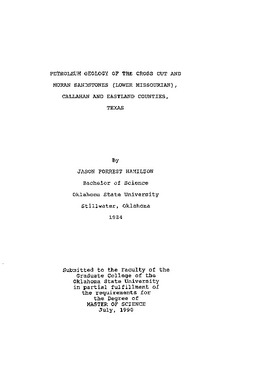| dc.description.abstract | In the study area in Callahan and Eastland Counties, Texas, the interval between the base of the Palo Pinto Limestone and the top of the Morris limestone (Pennsylvanian System, Lower Missourian Series, Upper Strawn Group) can be subdivided into three genetic units. They are, in ascending order (1) Lower Moran, (2) Upper Moran and (3) Cross Cut. These sandstones were deposited from east-southeast to west-northwest in a high constructive, elongate cratonic deltaic environment. Of the approximately five million barrels of oil produced from the Cross Cut and Moran in the study area, most came from the Upper Moran and to a lesser extent, the Cross Cut, whereas only a small number of wells produced from the Lower Moran. Depths of Cross Cut and Moran production range from 2100 feet to 2500 feet. Available cumulative production data indicate a rather consistent average of 30,000 barrels of oil per well. The sandstones are very fine- to fine-grained sublitharenites. Much secondary porosity is developed where abundant sand-sized clay grains and to a minor extent 1 feldspar grains have been partially or totally dissolved through diagenesis. Numerous tiny patches of ankerite cement are scattered throughout the sandstone section in the cores. Pore-filling vermiform kaolinite is the only authigenic clay present in significant amounts.� These sandstones, because of their well developed open pore systems with relatively little detrital matrix, authigenic clay or epitaxial cement, provide excellent petroleum reservoirs. Sandstone geometry, log signature, outcrop and core sedimentology and thin section petrology indicate three facies; (1) distributary channel; (2) distributary mouth bar and (3) delta front. Strand zone development inferred from "hingelines" detected on structure, sandstone isolith, and total interval isochore maps provide further evidence for the delineation of the�various facies and their relationships to one another. Production is obtained from all three facies. The Cross Cut and Moran fields in the study area are trapped by (1) stratigraphic termination of delta front sandstone lentils encased in shale, {2) up-dip pinch out of distributary channel complex sandstone or distributary channel sandstone against regional dip, or (3) compactional drape and/or up-dip pinch out of distributary channel sandstone related to underlying structure. | |
